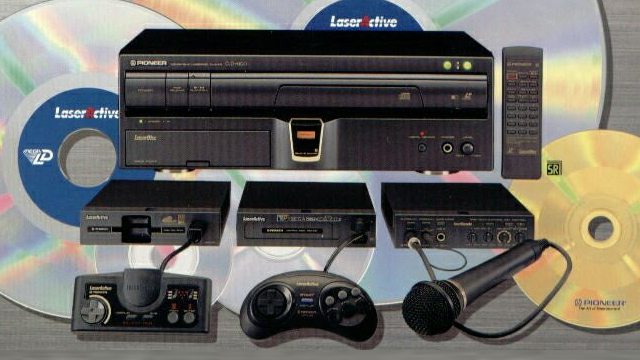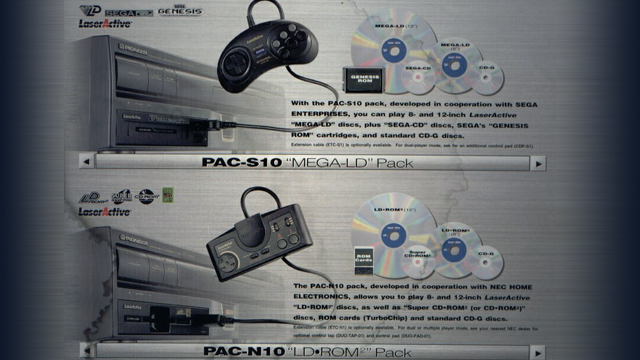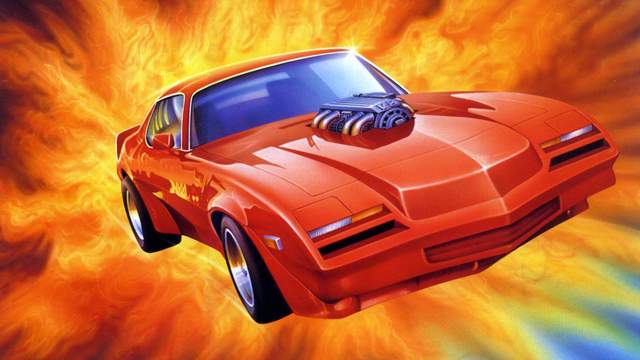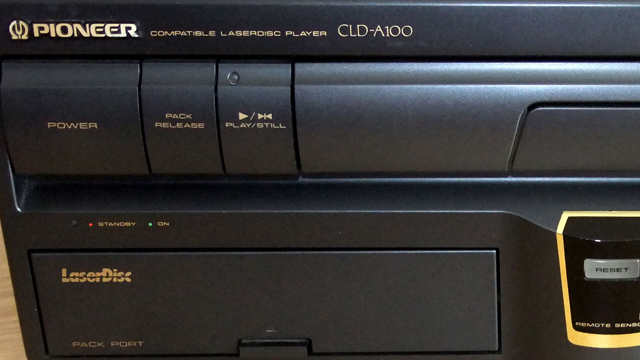
One of the biggest mistakes a console maker can make is putting a technological gimmick before the hardware itself. The dawn of optical media was a perilous point in games hardware history, with several platform creators rushing to take advantage of the new technology before the big players – Nintendo and Sega – could do it first. One such competitor, Pioneer, attempted to leverage an obscure medium while piggybacking on its more successful competitors to secure victory, but never obtained any compelling software. I’ll say it until I’m blue in the face: Software trumps hardware every time. The Pioneer LaserActive learned this the hard way.
The System
When it was introduced, optical media offered a lot of advantages over cartridges and floppy disks: it was compact, cheap and able to hold a lot of data. Before CDs took hold as the dominant format, a predecessor managed to carve out a niche for itself: LaserDisc. This format was used mainly for video, but there were several attempts to use it for games. In particular, some famous and influential titles such as Dragon’s Lair and Road Avenger were made for arcades using LaserDisc to store their data, something that would have been nigh-impossible and prohibitively expensive on other storage media of the time. LaserDisc was able to store higher-quality video than VHS tapes, even though they essentially functioned like records for video. The ability to use recorded video in games was a tantalizing prospect in the early ’80s, regardless of practicality.
Pioneer wanted to further promote the gaming potential of its now decades-old storage medium, and release a console which would use it as a unique selling point. The LaserActive was released in 1994, a gigantic machine sporting little more than the barebones video-playing hardware in all LaserDisc players, aside from a few auxiliary features. As with many disc-based systems at the time, it was mainly used for video with little interactivity.
Video quality was not even appreciably different than what was being done with encoding on CDs at the time; the capacity of a LaserDisc was approximately 540 megabytes, as opposed to the roughly 700 of CDs. This made it difficult to justify picking up the system instead of a cheaper alternative, such as a TurboGrafx-CD or Sega CD. The LaserActive launched for a dizzying $970 ($1536 when adjusted for inflation) for the base unit alone, keeping it out of most consumers’ budgets.
Pioneer seemed to realize its inadequacy on these fronts. It decided that, instead of funneling funds into original software development as a way of pump-priming developer interest in the hardware, the best course of action would be to piggyback on its aforementioned two biggest competitors in the CD console market. The company released a variety of expansion modules for the LaserActive called PACs, two of which allowing users to play Sega Genesis/Sega CD and TurboGrafx-16/Super CD games, respectively. These PACs costed an extra $600, and could take in both cartridges from those systems as well as override the disc drive to read discs from those respective CD add-ons. Each PAC also had its own exclusive titles released on LaserDisc which used the unique hardware for playing games. This actually ended up being the only means by which games were released for the LaserActive: owners had to purchase both PACs to experience the entirety of the system’s library, and no game was ever released that did not require either one.

The Story
A full ten years after Dragon’s Lair set arcades on fire, and with CD-based machines from NEC, Sega and Amiga on the horizon, Pioneer decided to step into the gaming market by leveraging its homegrown media format. The LaserActive was dropped into the tumultuous fray that was the early-’90s console market, left to fend for itself against the onslaught of newcomers. The media format showed its flaws when adapted to video games. Random reads from the analog LaserDisc were very difficult to accomplish, meaning discs were most easily read sequentially. This was all well and good for video. For games, which require sometimes random data access from across the entirety of the storage medium, it severely constrained the types of games which could be made. Because of this, “full-motion video” games became practically the only genre represented on the LaserActive, with quiz and one or two point-and-click adventure games to round out what was left of its meager library.
Even among games which played to the system’s strengths (or limitations, for that matter), LaserDisc showed its age next to the up-and-coming CD, even in the areas in which it supposedly excelled. It quickly became apparent that users were leaving LaserDisc behind for newer, cheaper CDs. The system was barely even able to secure a niche among wealthy home theater enthusiasts, the system’s target audience. The appeal of an all-in-one game system to that market was slim, and the vast majority of consumers simply chose to go the cheaper route and buy separate game systems and LaserDisc players.
Nevertheless, Pioneer continued to release new PACs for the system, as well as write off the production of a few titles that showed off its video capabilities. Desperate and searching for new appeal, Pioneer released add-ons such as a set of active 3D glasses, a PC link cable and a karaoke module. None of these succeeded in moving units, and instead the system stagnated due to its still-immense price point, confusing hardware configurations and tragically-undiverse software lineup. The LaserActive was discontinued by Pioneer a mere year after its release, deemed a critical and commercial failure by most of the industry.

The Possibilities
There is little diversity in the LaserActive’s software library, a fatal design flaw that seemed innate to the format itself. However, the system’s limited scope still netted it some interesting titles in the full-motion video genre. Road Avenger is often regarded as one of the most engaging FMV games to ever be released, and has since been ported to many other platforms. The LaserActive version may not be the easiest or even best way to play the game, but it is the most faithful port to the arcade original, since it uses the same video data copied over from the LaserDisc unit in the arcade cabinet.
Sega CD title Time Gal also received a port to the LaserActive, although differences in quality between the two versions are debatable. The TurboGrafx-CD’s classic detective series J.B. Harold also had two releases on the system, but as before, they were merely ports of the same games on other platforms. What original games were available on the system were not very high in quality; some minor exclusives include Vajra 1 & 2, rail shooters developed by the same studio that made the Rayxanber series, and 3D Museum, which used the 3D glasses to make a stereoscopic 3D point-and-click educational game.
The LaserActive’s key defining feature was also its fatal flaw: the media format itself. LaserDisc was not built for games, other than the minimally-engaging FMV titles that popularized the format. Any console with an entire game library built around a single genre in this way simply will not last. In past chapters of this series, I have argued for the rightful dignity and historical significance of forgotten and failed game platforms, while highlighting how they can still be relevant today. I am generally always able to find one good reason – one silver lining – that might make that console worthwhile in the modern age. But the LaserActive? There are better, cheaper LaserDisc players available, there are easier ways to play better versions of most of its games and even a set of all the console’s exclusives together would not justify the cost of this system. Unless you are among the most die-hard of game collectors, you can skip the LaserActive.




















